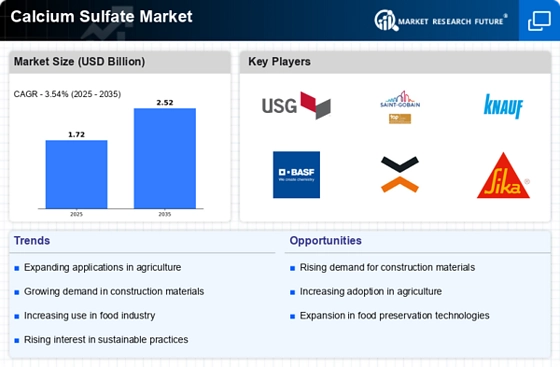Construction Material Innovations
Innovations in construction materials are driving the Calcium Sulfate Market forward. Calcium sulfate is increasingly utilized in the production of drywall and plaster, which are essential components in modern construction. The construction sector is witnessing a surge in demand for lightweight and durable materials, and calcium sulfate-based products meet these criteria effectively. Furthermore, the global construction industry is expected to grow significantly, with estimates suggesting a market size increase of over 10% annually. This growth is likely to bolster the demand for calcium sulfate, as it is favored for its fire-resistant properties and ease of application. Consequently, the Calcium Sulfate Market stands to benefit from these trends, as construction companies seek reliable and innovative materials.
Sustainable Agriculture Practices
The increasing emphasis on sustainable agriculture practices appears to be a pivotal driver for the Calcium Sulfate Market. Farmers are increasingly adopting soil amendments that enhance soil structure and fertility, and calcium sulfate is recognized for its ability to improve soil health. This mineral helps in reducing soil salinity and provides essential calcium to crops, which is vital for their growth. As agricultural practices evolve, the demand for calcium sulfate as a soil conditioner is likely to rise. Reports indicate that the market for soil amendments is projected to grow at a compound annual growth rate of approximately 5% over the next few years, suggesting a robust opportunity for the Calcium Sulfate Market to expand its footprint in the agricultural sector.
Diversification in Food Industry Applications
The diversification of applications within the food industry is emerging as a notable driver for the Calcium Sulfate Market. Calcium sulfate is utilized as a food additive, particularly in the production of tofu and as a firming agent in various food products. As consumer preferences shift towards plant-based diets, the demand for calcium sulfate in food processing is likely to increase. Market analysis indicates that the food additives segment is projected to grow at a rate of around 4% annually, which could enhance the prospects for the Calcium Sulfate Market. This trend reflects a broader movement towards healthier eating habits, where calcium sulfate plays a crucial role in ensuring food quality and safety.
Regulatory Support for Industrial Applications
Regulatory support for industrial applications is a significant driver for the Calcium Sulfate Market. Governments are increasingly implementing regulations that promote the use of environmentally friendly materials in various industries, including construction and agriculture. Calcium sulfate, being a non-toxic and sustainable option, aligns well with these regulatory frameworks. The push for compliance with environmental standards is likely to create a favorable market environment for calcium sulfate products. Additionally, the industrial minerals market is expected to witness a growth rate of approximately 6% in the coming years, indicating a strong potential for the Calcium Sulfate Market to capitalize on this trend. This regulatory landscape may encourage more industries to adopt calcium sulfate as a preferred material.
Technological Advancements in Production Processes
Technological advancements in production processes are poised to influence the Calcium Sulfate Market positively. Innovations in extraction and processing techniques are enhancing the efficiency and cost-effectiveness of calcium sulfate production. These advancements not only improve yield but also reduce environmental impact, making calcium sulfate a more attractive option for various applications. The mineral processing industry is projected to grow at a rate of around 5% annually, suggesting that the Calcium Sulfate Market could benefit from these technological improvements. As production methods become more sophisticated, the quality and availability of calcium sulfate are likely to improve, further driving its adoption across multiple sectors.

















Leave a Comment